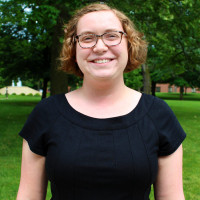Root-Level Community
As part of the team that wrote the Spirit of a Forester language in 2019, Nicole is sharing the heart behind each of the seven Forester traits and their practical applications. Today’s trait: Foresters Embrace Interconnectedness
When we first talked with alumni about the Spirit of a Forester concept and what the traits of a Forester could be, we knew one word would come up often: community. We knew this because alumni have been talking about HU’s strong sense of community since the very beginning.
Rufus Morrison, a member of our first graduating class in 1899, talked about community in his graduation speech, remarking that he and his classmates “formed endearing attachments with professors and fellow students which we are loath to break.” More than 100 years later, Foresters still know that one of the best things about HU is its community atmosphere. Community was definitely going to have to be in the Spirit of a Forester language somewhere.
You might have noticed, however, that “community” is not one of the seven traits.
To be honest, this was a subject of much discussion in the writers’ room and in our focus groups. We didn’t want to use the word community casually — we wanted to capture the essence of what a community is and why living in community is a Forester’s strength. In the end, “embraces interconnectedness” became the Spirit of a Forester trait that encapsulated community.
For Foresters, the concept of interconnectedness makes sense. Entwined tree roots and forest fungi work together to store rainwater, share nutrients, and stabilize the soil. A healthy forest has trees that stand together above ground and are interconnected with each other under the surface.
Similarly, we want Huntington University to be a healthy community that supports growth. We strive to connect deeply with each other at the root level and stand shoulder to shoulder above the surface. Our community is our strength because it interconnects us, and we embrace that interconnectedness wholeheartedly.
I like our use of the word embracing because it leaves room for the community to grow and improve over time. We can’t just find good community accidentally or force it to remain exactly the same forever. We might need to make adjustments once in a while to ensure we are loving our neighbors well. Interconnectedness doesn’t need to be perfect. What matters is that we continue to embrace opportunities to form meaningful, God-honoring relationships.
In a university setting like ours, it is important to note that our interconnectedness isn’t just about how well our personalities fit together. We are also interconnected through the subjects we study.
Sometimes this shows up in interesting ways. For example, I have always been interested in two “competing” subjects: English and math. I liked math enough that I took the AP Calculus Exams. Although I picked a career that leans into English skills, I am convinced that math strengthened me as a writer. Math’s orderly beauty and language arts’ rich meaning are interconnected in who I am and how I express myself. Perhaps you also have an interest in a career that crosses genres.
At Huntington University, collaborative work between departments is commonplace. That’s the benefit of a liberal arts education in a community atmosphere. Even if you are only interested in one subject, one career path, our goal is to develop your skills while introducing you to the other subjects that stand alongside you in the Forest. Because under the surface, you never know how the community of perspectives you encounter here will strengthen you.
By embracing our interconnectedness, we can grow together — as a thriving community.

